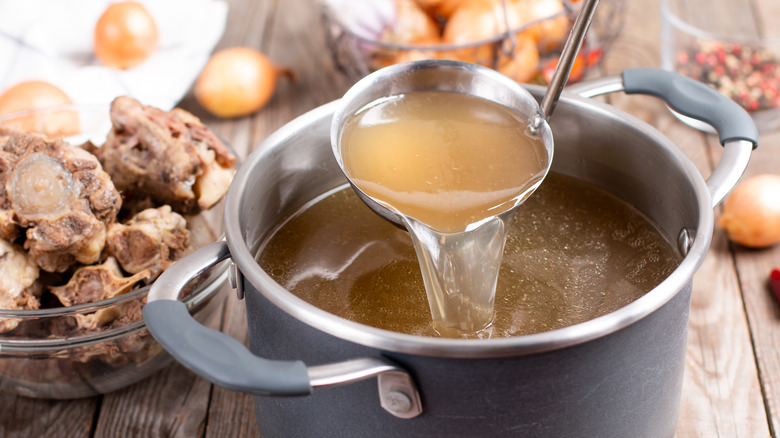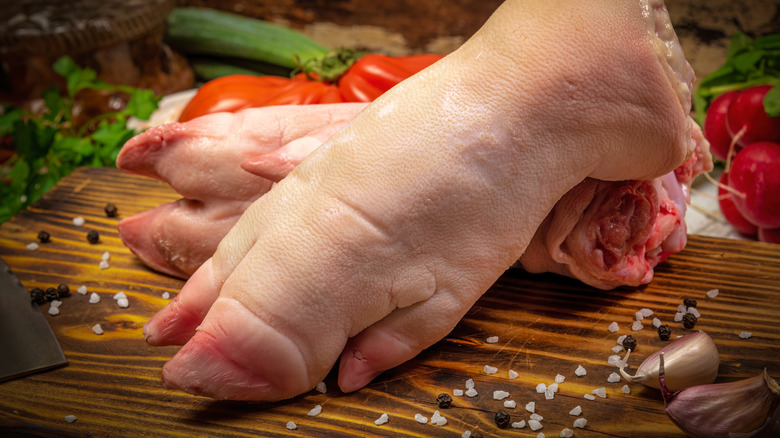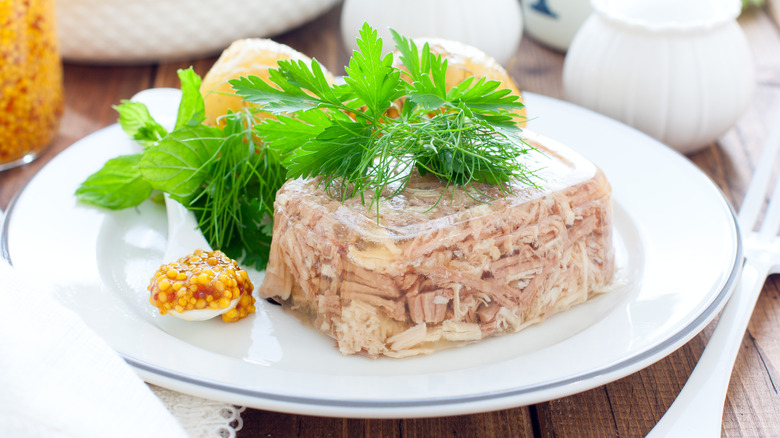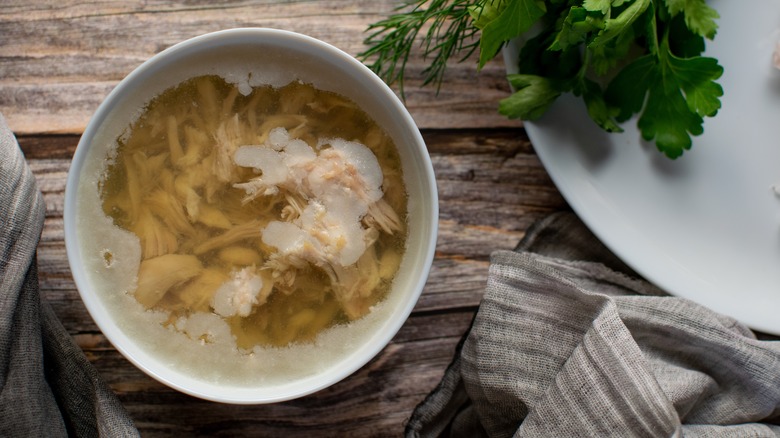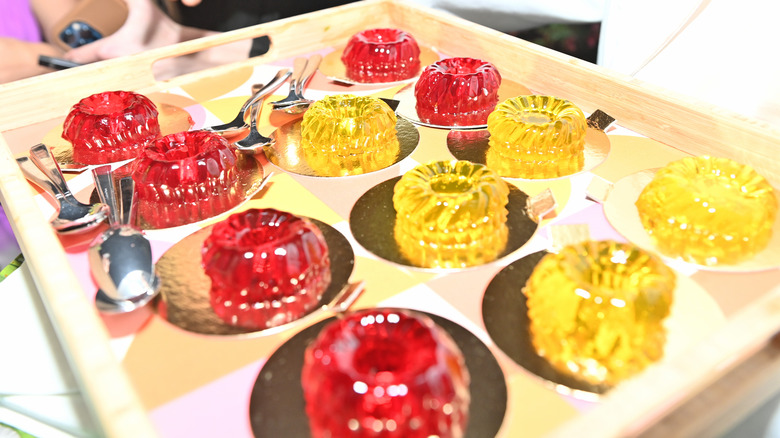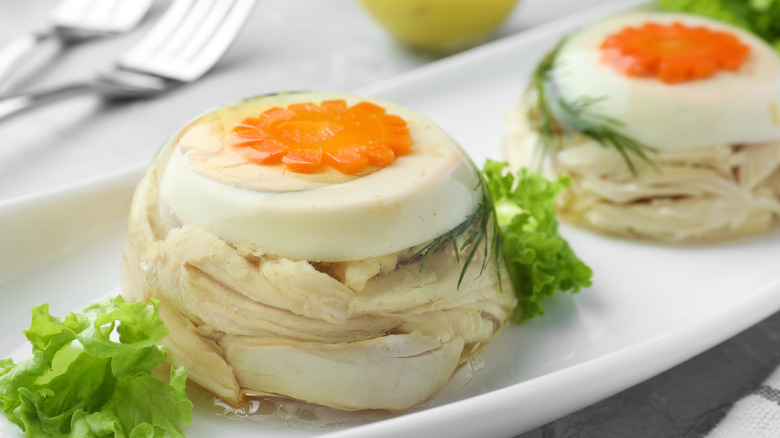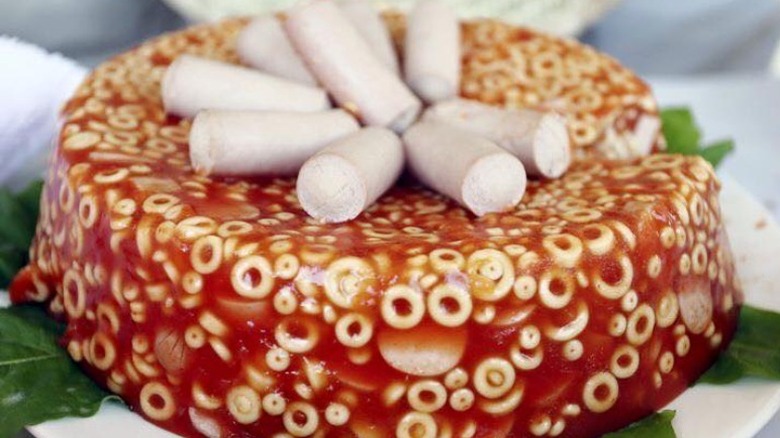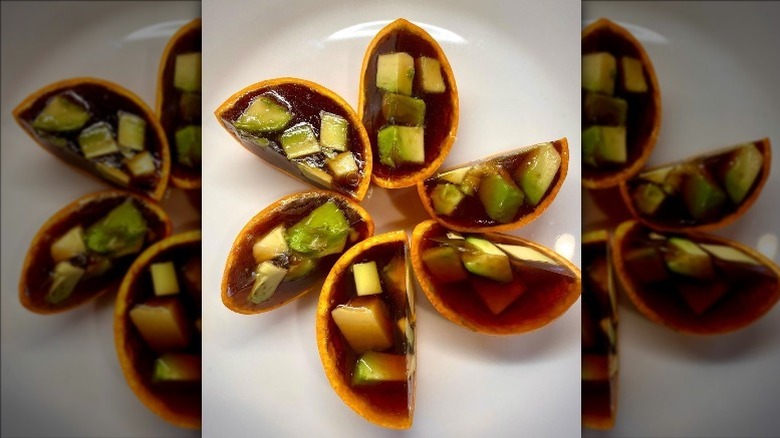Everything You Need To Know About Aspic
Sure, we all have our own dishes and ingredients we don't like, but some dishes get an unfair amount of hate. One of those dishes? Aspic. If you've never heard of it before, you're not alone. But if you have heard it before, you might have an undesirable opinion on it already. That's fair — it's a polarizing food. But a lot of people out there (especially those of us who live in the U.S. and are under 60 years old) have never even tried aspic.
So what's all the hate about? First of all, aspic looks kind of weird, kind of futuristic, but at the same time kind of old school. But there's also that unfair association with all those weird Jell-O salads that float around the internet every few months. These negative impressions mean that some of us will never get to savor the fun, jelly-like joy that is quality aspic.
Before you completely write it off your to-try foods list, you should get the scoop on what aspic's really about. You may just find that it doesn't sound as bad as you've been led to believe. Who knows? You may soon find yourself boiling some cow hooves to make your own aspic at home.
Aspic is meat broth transformed into a jelly-like substance
For those who have never heard of aspic before, let's start with the basics. In the simplest terms, Vintages Recipes and Cookery defines aspic as "a savory stock made from cooking meat slowly, creating a natural gelatin that thickens, then turns to a jelly when it cools." Gelatin, of course, is the stuff that gives Jell-O its strange, jiggly consistency, but aspic is, blessedly, conspicuously devoid of the artificial grape flavoring. Rather, once you've boiled your aspic and it comes together in the fridge as a cooled, congealed hunk of meat-infused jelly, it takes on a much saltier, more savory note than probably any of the Jell-O you've ever tried in your life.
In France, a version of aspic is often called chaud froid, which literally translates to "hot cold." That makes sense when you consider that you have to boil meat broth to make aspic in the first place, but to enjoy it, you have to let it chill. If you've ever had bone broth before, you've had something really similar to aspic. When it's in a cool environment, it turns to a solid. However, once you place it into a pan and start heating it up, it takes on more of a liquid quality. Aspic does the exact same thing.
It's made from the skins, bones, and cartilage of animals
In some parts of the world, it's commonplace to use all parts of a butchered animal — some cultures make sure that nothing goes to waste. In the United States, that's not always the case, which contributes to people's weird feelings about eating organ meats. Therefore, you may flinch when you find out that aspic is made from collagen-rich animal parts, including skin, bone, cartilage, and tendon, according to Michelin Guide. When you boil these parts down, they release collagen, which gives aspic its signature jelly-like texture.
While that might sound off-putting if you're not used to eating these parts of animals, you should know that you're generally not going to find any hunks of bone or tendon in your aspic — this stuff is already strained out before reaching your plate. But you should also keep in mind that the collagen in aspic can actually be extremely beneficial health-wise. According to WebMD, collagen is great for your skin as it can promote elasticity (which can prevent early aging). Who knew that eating aspic could have positive health and beauty benefits?
It has a few different uses
You may even wonder why something as strange and jiggly as aspic was even created in the first place. But as it turns out, aspic boasts a few different uses. These days, it's often used to simply place food into molds, according to Encyclopaedia Britannica. Canned tuna and sliced olives aren't going to turn themselves into a congruent loaf, but when you coat them in aspic and let them cool in the fridge, they soon get melded together into one sliceable dish.
But back in the day, cooks used aspic for a different purpose. Before refrigeration, foods exposed to too much oxygen (so, basically, all of them) would spoil quickly. Therefore, cooks and homemakers wanted to make sure that as much food as possible actually made it to the dinner table. Using aspic would seal foods like meat in an oxygen-free environment, thus preventing the growth of bacteria that would eventually lead to spoilage. Admittedly, we probably don't need to use aspic for that purpose anymore since using a refrigerator is generally our best bet for preserving food. Still, you have to give it up for those who thought of aspic as a method of preservation in the first place — it's a pretty solid idea.
It's notoriously labor-intensive to make
Yes, aspic is relatively simple in theory, but what if you're the one in the kitchen actually cooking it? In that case, you may not find aspic very simple at all. While there are some shortcuts you can take these days, traditionally, aspic has been a very labor-intensive food, per the Michelin Guide; they call it "notoriously laborious to make."
That checks out when we take a closer look at the recipe for it on the Prepare & Nourish blog: The total cook time is a whopping 10 hours, and that's in addition to 30 minutes of prep time (though four of those hours are dedicated to cooling). Also, keep in mind that this modern-day preparation of aspic makes use of a slow cooker, which wasn't an option back in the day.
Aspic takes so long to make because the cook must boil the bones and cartilage long enough to release the gelatin that gives aspic its signature jiggle. So, want to make aspic at home? You totally can, and it shouldn't even be too difficult if you make sure you follow the recipe of your choice, but let's be clear: It's not a five-minute appetizer. Be sure to give yourself plenty of time to prepare your aspic.
Aspic is popular in French and Eastern European cooking
Yes, aspic has appeared in American food over the course of this nation's short history, but the U.S. certainly isn't the only place where aspic has left its culinary mark. In fact, many Americans were introduced to aspic in the first place through Julia Child's cooking: The famous cookbook author included a variety of French aspics in her work, per PBS.
But you won't just find amazing aspic recipes coming from France. Eastern Europe is also famous for its use of aspic. The ingredient is generally regarded as a winter food to make dishes like kholodets, which is made with pork bones and then served with horseradish and beet sauce, per Let the Baking Begin. Poland is famous for its jellied pigs feet, which taste better than it sounds.
These aren't the only countries and regions that have found ways to put aspic to good use. Look carefully enough, and you'll find that there are delicious aspic dishes from all over the globe to savor.
Soup dumplings contain aspic
One popular food that you might not be aware contains aspic is soup dumplings or xiaolongbao, according to Mashed. If you've ever had them before, you know they're a delight unlike anything else. This iconic food hails from China, where they were invented in the late 1800s. No, they're not dumplings that go into a soup; they're dumplings with broth inside. You may be wondering how on earth liquid broth can find its way into a dumpling that has to be made by hand. Well, it's simple: aspic.
When the aspic is cooled, it's formed into a little ball that can be easily placed inside the dumpling dough. Then, the dough is formed into its proper shape. Once the dumpling has been steamed, the aspic gel heats up enough to turn into a liquid. This is why you can bite into a dumpling that's bursting with hot broth.
These days, soup dumplings have reached new heights of popularity in the U.S., and it's no wonder why — not only are you greeted with a hot slurp of soup once you bite into your chewy dumpling, but you also have a ton of fun eating it. But those who aren't familiar with how soup dumplings are made may be surprised to find out that they have aspic to thank for this incredible culinary invention.
Aspic and Jell-O are related
When you hear about a jiggly, congealed jelly-like substance, what first comes to mind? If you're like a lot of people, you probably think of Jell-O, not aspic. But did you know that the two foods are actually quite similar? First of all, there's a clear difference in taste. Your average package of lime Jell-O is going to taste nothing like beef aspic. However, the consistency will be very similar, and that's because Jell-O is actually derived from the same sources as aspic (per Mashed), i.e., from the skin, bones, and cartilage of animals.
If you take a look at the ingredients label on a package of Jell-O (from Harvard University Dining Services), you'll see that "gelatin" is listed, but the label doesn't say where that gelatin comes from. It makes sense — some consumers probably wouldn't be too happy to find out that they were eating boiled-down pig ligaments. But if you've ever heard a vegan say that they don't eat Jell-O, this is why: It's basically just flavored aspic.
It was (and still is in some circles) considered a fancy dish
According to MyRecipes, when aspic first came onto our modern food radar, it was considered haute cuisine, and it makes sense when you consider what a time-consuming process it is to make the dish. Most common people probably wouldn't have the time (or a servant) to spend hours over the stove to make gelatin that then had to be cooled. But then, the industrial revolution started, and aspic was poised to become much more common.
First of all, there was the invention of powdered gelatin. Let's face it, boiling down a bunch of cow hooves isn't the best way to spend your afternoon. So, powdered gelatin was a big deal — it took a ton of the work out of an intensely labor-intensive process. But you still had to find a way to cool it. By the time refrigerators came along, companies actually pushed aspic recipes to encourage middle-class people to buy refrigerators.
Even if aspic suddenly became more accessible to some, it never lost its ability to shock and delight. Something about a jiggling mass of gelatin wriggling its way out of a mold to be revealed, shining and beautiful, on a plate before an audience of guests will never get old. Even if you never wanted to touch grandma's weird Jell-O salad, you have to admit that it at least looked pretty cool.
Aspic reached its heyday in the U.S. in the 1960s
Aspic has been around before the U.S. even existed, but in America, aspic-based dishes reached the height of popularity around the 1960s, according to Now This News. But the American version looks quite a bit different from the French and Eastern European preparations that had been served up until that point. In the U.S., aspic was often laced with a variety of fresh vegetables and even canned products like tuna and chicken. Occasionally, aspic would even contain olives or mayonnaise.
Of course, eating these foods in what we now consider to be a Jell-O mold might seem like a strange practice these days, but at the time, aspic was at the height of dinner party trendiness. Again, you don't necessarily have to want to eat it to appreciate that aspic can take interesting and even beautiful forms. Truthfully, we wouldn't totally mind if savory aspic made a resurgence in the modern day. We can only sit and wait or make it for our next dinner party ourselves.
There have definitely been some strange aspic creations
Of course, just because some aspic recipes don't look awful doesn't mean that all of them are as innocuous as they may seem. There are other aspic recipes out there that can only make us shake our heads in overwhelming confusion that someone dreamt these recipes up in the first place and whether these creators ever took a bite.
The ones that seem to bother people the most are the aspics that contain hunks of meat, as referenced by a Ranker article that depicts a wide range of meat-studded aspics. The eel-infused aspic is especially disturbing, but the asparagus and octopus version somehow, inexplicably, molded inside a watermelon, has to be worse. On the other hand, Atlas Obscura reported that author Ken Albala tried to make a sake-infused aspic with baby octopi, which actually looks pretty good. And maybe we just have weird tastes, but the recipes that include hot dogs don't look that bad either. Hey, they're not for everyone, but they could be for us.
Aspic is now being used as an art form
It might go without saying that aspic has earned itself somewhat of an unfavorable reputation in America, but that doesn't mean it hasn't captured our attention. We love looking at it, even if we're not eager to actually eat it. According to Today, some people are actually viewing aspic as a medium for making art. It makes sense when you see a great wobbling aspic-imbued creation in front of you. When the ingredients are placed just right, aspic molds can be stunning.
While we may be fascinated in a more ironic way by aspic than we were in the past, the truth is that anything beautifully shaped that encases colorful ingredients is going to be eye-stopping, so we totally get why people would serve the stuff back in the day. When you have friends over for a dinner party and want to impress, showing up at the table with a jiggling "salad" was probably a great way to do it.
Eating aspic can be a way to reduce food waste
The USDA says that around 30% to 40% of the country's food supply is wasted. And since, according to the World Resources Institute, meat is so much more resource-intensive to produce than plant-based foods, wasting meat is a huge problem. But here's the thing: Not everyone likes to eat bones, organ meats, and other parts of animals that are unfairly (if you ask us) deemed undesirable. If, after preparing dinner, you have bones, tendons, or cartilage that you were just going to throw into the trash, consider using it to try your hand at making aspic. It's a fun project to try, and it'll help you squeeze more money out of your grocery run.
Of course, you may not always have the time or energy (or even the desire) to make aspic from scratch, but knowing different ways to use your food scraps can help cut down on the food waste from your kitchen. Plus, it can save you money on groceries in the process. If you're a home cook feeling adventurous, give aspic a try.

